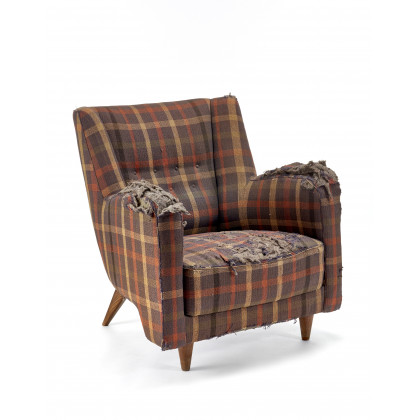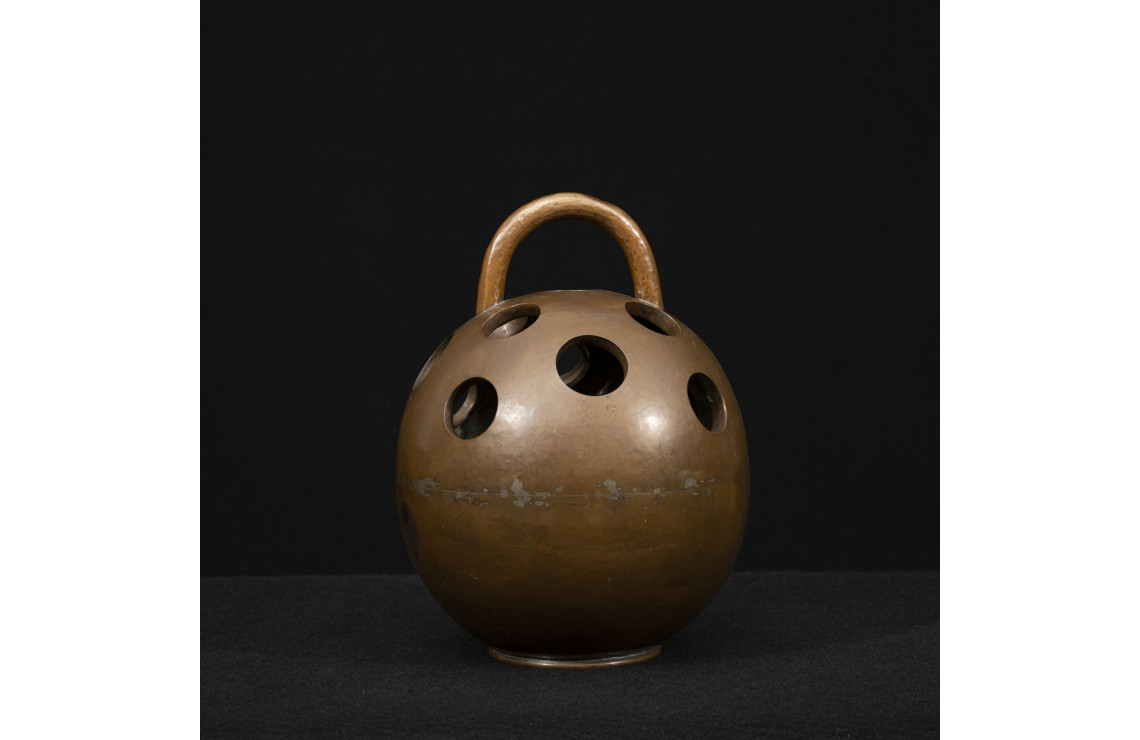Gio Ponti (Milan. 1891-1972) A COFFEE TABLE FOR THE CONTINI BONACOSSI RESIDENCE, VILLA VITTORIA, FLORENCE, 1932 walnut, gilded brass height: 56 cm, diameter: 79.4 cm Bronze nameplate reading ‘ Gio Ponti ’ on one leg Appraisal delivered by the Gio Ponti Archives, no. 18144/000, on 10 September 2018 Provenance Residenza Contini Bonacossi, Villa Vittoria, Florence; Private collection by descent from the above, Florence VILLA VITTORIA. GLI AMBIENTI ED IL LORO ARREDO Enrico Colle Alessandro Contini Bonacossi was born in Ancona in 1878. With his wife Vittoria Galli, he commenced his activity as a collector and dealer in paintings and sculptures, primarily works by artists of the Italian schools, during his stay in Spain, which lasted until 1918 when he moved to Rome with his family. During those years, Contini travelled many times to the United States, where he met numerous fellow collectors with whom – besides closing advantageous deals which permitted him to considerably augment his collection – he forged lasting friendships. Thanks to their frequentation of the homes of New York’s magnates and to their relationship with Piemontese industrialist and collector Riccardo Gualino, an attentive admirer of the trends in the art and architecture of his time, the Continis developed a refined taste in furniture and furnishings as well. When they moved to Florence, Alessandro and Vittoria Contini Bonacossi’s appreciation of the solemn and at the same time functional villa built by Marchese Massimiliano Strozzi in that area of the city which at the time was still known as Valfonda was immediate; they saw the building – of recent construction but of noble origins – as the ideal venue to which to transfer their collection. The spacious rooms, with their austere neo-16th-century decoration, were well suited to showcasing the masterpieces of Italian Renaissance and Baroque painting and sculpture which the Continis had purchased, along with objets d’art and furniture, from the very early years of the 20th century onward; and the top floor of the villa lent itself admirably to rational reconstruction for conversion into a comfortable, elegant living space. The villa was purchased in 1931, renamed Villa Vittoria in honour of Contini’s wife, and soon refurbished according to precise museum layout criteria: the ground and first floors became home to the old masters collection, while the second floor, where the owners also lived, hosted works by contemporary artists. During the years the family was in Florence, the best-known private collections were those of Frederick Stibbert, Herbert Horne, Stefano Bardini and Elia Volpi. A common denominator linked all these collections, amassed between the late 1800’s and the early years of the 20th century: imaginative, original arrangements of the pieces in rooms filled to capacity with objects and artworks. The only non-adherent to this style was Bernard Berenson, who in his villa I Tatti arranged his paintings and objets-d’art along the walls at a correct distance to keep them from ‘interacting’ with one another. The Continis took Berenson’s home as their model and placed their period pieces in sober, suggestive surroundings that strongly favoured rarefaction over accumulation. Then again, over the course of the Twenties Italian architects and interior designers tended more and more to exclude profuse displays of objects in rooms, preferring a style of furnishing that was more functional but in which even the work of ancient art had its precise place. Complementing their celebrated collection of ancient art, the Continis had also begun to purchase works by contemporary artists, which they arranged on the top floor of the villa where the family habitually resided; a special layout was created, with furnishings designed by then-emerging architects Gio Ponti and Tommaso Buzzi of Milan and Giulio Rosso of Rome. The apartment, completed in 1932 or at the latest in the winter of the following year
Gio Ponti (Milan. 1891-1972) A COFFEE TABLE FOR THE CONTINI BONACOSSI RESIDENCE, VILLA VITTORIA, FLORENCE, 1932 walnut, gilded brass height: 56 cm, diameter: 79.4 cm Bronze nameplate reading ‘ Gio Ponti ’ on one leg Appraisal delivered by the Gio Ponti Archives, no. 18144/000, on 10 September 2018 Provenance Residenza Contini Bonacossi, Villa Vittoria, Florence; Private collection by descent from the above, Florence VILLA VITTORIA. GLI AMBIENTI ED IL LORO ARREDO Enrico Colle Alessandro Contini Bonacossi was born in Ancona in 1878. With his wife Vittoria Galli, he commenced his activity as a collector and dealer in paintings and sculptures, primarily works by artists of the Italian schools, during his stay in Spain, which lasted until 1918 when he moved to Rome with his family. During those years, Contini travelled many times to the United States, where he met numerous fellow collectors with whom – besides closing advantageous deals which permitted him to considerably augment his collection – he forged lasting friendships. Thanks to their frequentation of the homes of New York’s magnates and to their relationship with Piemontese industrialist and collector Riccardo Gualino, an attentive admirer of the trends in the art and architecture of his time, the Continis developed a refined taste in furniture and furnishings as well. When they moved to Florence, Alessandro and Vittoria Contini Bonacossi’s appreciation of the solemn and at the same time functional villa built by Marchese Massimiliano Strozzi in that area of the city which at the time was still known as Valfonda was immediate; they saw the building – of recent construction but of noble origins – as the ideal venue to which to transfer their collection. The spacious rooms, with their austere neo-16th-century decoration, were well suited to showcasing the masterpieces of Italian Renaissance and Baroque painting and sculpture which the Continis had purchased, along with objets d’art and furniture, from the very early years of the 20th century onward; and the top floor of the villa lent itself admirably to rational reconstruction for conversion into a comfortable, elegant living space. The villa was purchased in 1931, renamed Villa Vittoria in honour of Contini’s wife, and soon refurbished according to precise museum layout criteria: the ground and first floors became home to the old masters collection, while the second floor, where the owners also lived, hosted works by contemporary artists. During the years the family was in Florence, the best-known private collections were those of Frederick Stibbert, Herbert Horne, Stefano Bardini and Elia Volpi. A common denominator linked all these collections, amassed between the late 1800’s and the early years of the 20th century: imaginative, original arrangements of the pieces in rooms filled to capacity with objects and artworks. The only non-adherent to this style was Bernard Berenson, who in his villa I Tatti arranged his paintings and objets-d’art along the walls at a correct distance to keep them from ‘interacting’ with one another. The Continis took Berenson’s home as their model and placed their period pieces in sober, suggestive surroundings that strongly favoured rarefaction over accumulation. Then again, over the course of the Twenties Italian architects and interior designers tended more and more to exclude profuse displays of objects in rooms, preferring a style of furnishing that was more functional but in which even the work of ancient art had its precise place. Complementing their celebrated collection of ancient art, the Continis had also begun to purchase works by contemporary artists, which they arranged on the top floor of the villa where the family habitually resided; a special layout was created, with furnishings designed by then-emerging architects Gio Ponti and Tommaso Buzzi of Milan and Giulio Rosso of Rome. The apartment, completed in 1932 or at the latest in the winter of the following year















Testen Sie LotSearch und seine Premium-Features 7 Tage - ohne Kosten!
Lassen Sie sich automatisch über neue Objekte in kommenden Auktionen benachrichtigen.
Suchauftrag anlegen